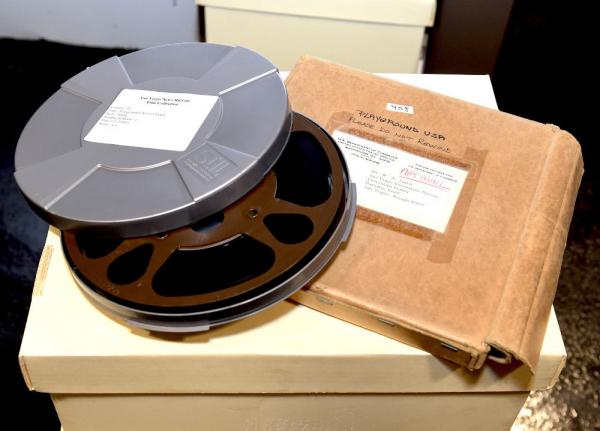Tips on Applying for a Preservation & Access Award

Photos of the Las Vegas News Bureau's vault that illustrate how a Preservation Assistance Grant improved its archival storage. Thursday, May 11, 2017.
Glenn Pinkerton/Las Vegas News Bureau

Photos of the Las Vegas News Bureau's vault that illustrate how a Preservation Assistance Grant improved its archival storage. Thursday, May 11, 2017.
Glenn Pinkerton/Las Vegas News Bureau
We’re delighted that you’re planning to apply to an NEH Preservation & Access grant program. Since even a great idea and collection are only part of a competitive application, we’d like to offer some tips that can help your proposal be competitive. These suggestions augment guidance from a 2008 article in Humanities magazine entitled “How to Get a Grant from NEH.” As emphasized there, none of this is intended to supersede instructions found in application guidelines (aka Notices of Funding Opportunity). Instead, we present it as a set of considerations that could help you develop a highly competitive application.
GETTING STARTED:
- Get started as early as you can. Register on SAM.gov, familiarize yourself with www.grants.gov, begin drafting your proposal in time to solicit input and share the document with contributors, and ask contributors for materials such as resumes, vendor quotes, and letters of support or commitment.
- Read the Notice of Funding Opportunity (i.e., guidelines) carefully, before and after completing your first draft. Is your project eligible? Did you address every requirement? The information contained there is critical.
- Read the sample narratives and budgets on the program’s webpage.
WHY FUND THIS? SIGNIFICANCE AND IMPACT:
- Make your project’s contribution to the humanities explicit. The importance of your subject is not self-evident. For example, why is your collection worth preserving? Are you making new documents accessible? Blazing new historiographical trails? As much as possible, connect your project’s local or regional humanities importance to larger humanities themes. Show the type of impact your project will have. How will NEH funding move your institution forward? In addition to immediate, tangible outcomes—say, better storage—explore future benefits.
- Your audience is likely part of your argument for significance and impact. Don’t forget to demonstrate how this collection is important to them, how the project may impact them, and who they are, from visitors to curators, researchers to K-12, and families with children to lifelong learners.
GET A LITTLE HELP FROM YOUR FRIENDS:
- Learn about grant writing from websites, workshops, webinars, and your institution’s grants office. Have your draft reviewed by someone with successful grant-writing experience. Consult a library, archive, or museum in your community that has received federal funding. You can search a database of NEH-funded projects on the website.
- Reach out to people beyond your institution when selecting advisory board/committee members, writers of reference or commitment letters, or partners. This can add credibility and useful resources and broaden your project’s impact. Be sure to discuss your project and share a draft of your proposal with these parties.
- If our grant program offers the option, submit a draft to @email for staff comments by the draft deadline provided on the website. Applications first submitted as drafts have a higher rate of receiving awards.
PUTTING VIRTUAL PEN TO PAPER:
- Outline your project clearly. The narrative should say where your project has been, where it is now, and where you want to go. Follow the Notice of Funding Opportunity for each section of the narrative.
- Describe what’s in your collection, perhaps highlighting a standout item(s) or area(s). Be specific about numbers—linear feet, items in various media, etc.
- It’s often easier for reviewers to assess a work plan that’s formatted as a table or bulleted list. Use a timeline with a monthly or quarterly breakdown. Clarify who is responsible for which task to aid your own planning for project management and budget, and to help peer reviewers assess how much work realistically can be accomplished.
- Pay attention to all evaluation criteria. For example, sustainability: how will the project continue to deliver outcomes into the future? Dissemination: how do your outreach plans go beyond simply using social media and conference presentations?
- Make sure you understand the instructions for developing a budget, that your numbers are accurate, that you’ve made a case for all purchases or hires, that the budget reflects your work plan, and that all items are eligible.
- A few images often can help to illustrate a project’s significance. They can be placed in the narrative or an appendix.
- Highlight the strong points of your institution and the participants, as relevant to the project.
- Keep in mind what makes you enthusiastic about this project. If you’re using a grant writer, then the project director, who knows the proposal’s value best, should work closely with that person. The project director should join in on any phone calls with the NEH.
- Mention any other grants you’ve received that show others have supported your work in this area.
AND IN CLOSING:
- Application deadlines are very firm. Consider officially submitting in Grants.gov no later than a day before the deadline to give yourself time to deal with any unforeseen technical problems.
If you have questions, please contact the Division of Preservation & Access at @email or 202-606-8570. We look forward to seeing your proposal!